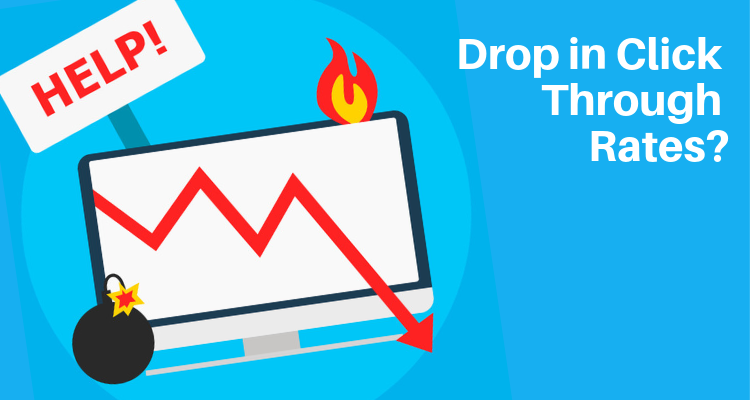Click Through Rates (or CTR) have historically been an indicator of the quality of the results that are displayed in the search engine results page. The calculation of a click through rate is the percentage of search results clicked divided by those that were displayed to the user (aka impressions). For instance, if a searcher clicks one search result after navigating the first page of Google, the CTR is 10% (1 out of 10 results were clicked).
Why Are the CTR Dropping?
Quite simply, more search satisfaction is being achieved, without the searcher needing to click on the search results themselves anymore which is often called a “No Click”.
Voice Search
Voice search is slowly but surely gaining momentum with searchers, and is forecast to have an even larger impact on the way users search in the future. Pure voice search generally only returns one search result, which has a profound impact on CTR.
Google Ads
An increase in paid ads (Google Ads) that are listed on the search engine results page. In 2019, 7 out of 17 results are now paid Google Ads (depending on the query & location). This is a 25% increase in displayed ads over the last few years.
SERP Features
Another major factor in the decline of CTR is the increase in SERP features (Answer Box, Featured Snippets, Tables, Knowledge Graph, Maps etc) that Google has implemented in the past few years.
These SERP features are often referred to “zero results”, “no click” or “position zero”, whereby the search goal is being satisfied without the need to click on results. This is increasingly true on desktop searches, but unsurprisingly the most dramatic change has occurred on mobile devices:
What Are SERP Features?
SERP features can be defined as any result from a search engine that isn’t a traditional organic result. These results tend to be richer and more graphical in content. Below are a few examples of the more common SERP features.
Instant Answer
Answers the searcher’s question without requiring them to click any search results:
Knowledge Panel
Summarises the key information about an entity from various online information sources.
Google Local Listings
These listings use proximity-based & contextual search results and enable searchers to call, navigate or even book directly from the listing. They also display the phone number for desktop users to call without visiting the organisation’s website.
Should You Be Concerned?
The good news is that the decline in traffic is affecting all industries, and the searchers really haven’t gone anywhere- they’re still very much using Google et al for their searches.
The bad news is there is considerably less traffic being driven to websites in 2019. That so much is unequivocal. Luckily, with the ever-increasing search volumes, the reduction in CTRs may only result in minimal traffic reductions.
The worse news is, it will require more effort and a higher investment to achieve the same level of SEO success as in the past. The search landscape is now far more competitive and the “prize” has become even more coveted.
An investment in Google Ads is also more likely required to retain a significant portion of real-estate of the search results, as the click through rates of paid Ads has almost doubled in the past two years.
What Can You Do to Optimise Your CTRs?
It’s not all doom and gloom, and there’s much you can do to optimise your existing pages to maximise their click through rates.
Know Your Current CTR
Log into the Google Search Console
And click performance:
To the right, you can see your overall (or average) CTR
Scroll down to the “Queries” and find any searches that have a low (< 5%) CTR.
Here are a few tips to help those pages with poor click through rates:
Improve Your Page Titles
Try to focus on using emotions- love, anger, fear, curiosity, shock etc. These entice searchers to click results at a higher rate. Ensure the title is the correct length (<70 characters), is unique and easily readable
Use Descriptive URLs
The URL you choose for the page (aka slug) is also an important factor that searchers will pick up on when scanning the SERP that help to increase your CTR.
Write Compelling Meta Descriptions
Meta Descriptions are the snippets of information that are displayed in the search results and have a huge impact on click through rates. Meta Descriptions need to be compelling and include a call to action to encourage the searcher to take further action by clicking the link.
Implement Structured Data
Structured data assists the search engine to better understand the content of your site. Many structured data types enable richer content displays that make search results more visible.
Use Shorter Sentences
Using shorter sentences and paragraphs make online content easier to read and improves the chance of your content being picked up by Google as a SERP feature.
Use Lists in Your Content
Lists (either numbers or bullets) have demonstrated an increase in CTR. This format makes information easier to scan and digest, hence it’s popularity.
Optimise Site Speed
If your site takes too long to load, it’s inevitable that people will abandon your site visit, affecting CTR.
Use “long Tail” Keywords
Include “long tail’ specific keywords in question and answer format in your content, such as “Where is the best place to get japanese food in bondi junction?” this increases your chances of being listed in position zero and voice search.
Summary
Click Through rates are dropping rapidly, especially on mobile, where now the majority of search results are categorised as “no click”. There are various reasons for this, such as an increase in Google Ads results, SERP features and voice search. It’s likely CTR will drop even further over time, with the increase in voice search especially.
In this article, I’ve provided some few suggestions to improve your CTR for organic search results.
If you learnt something new, check out these other SEO articles:
